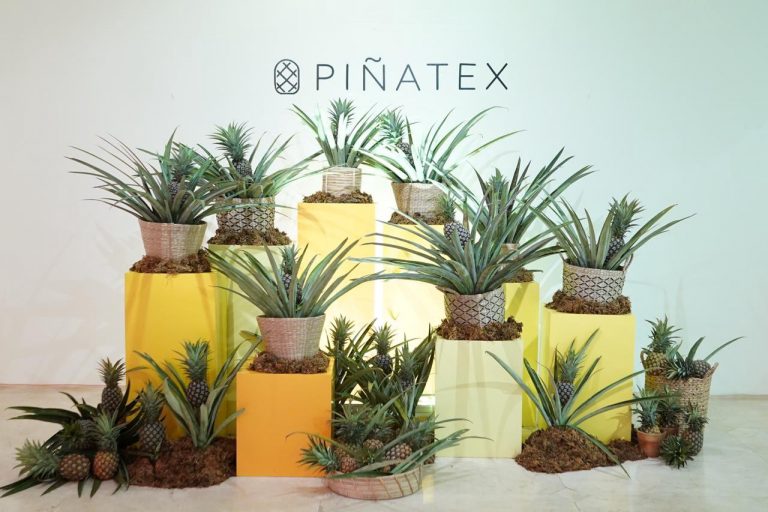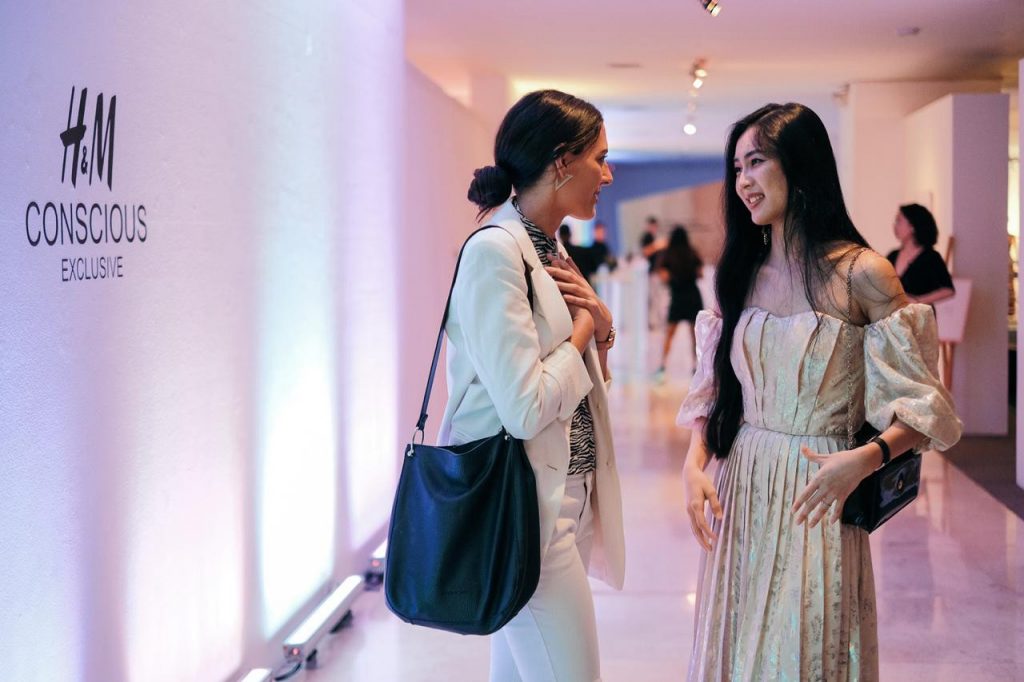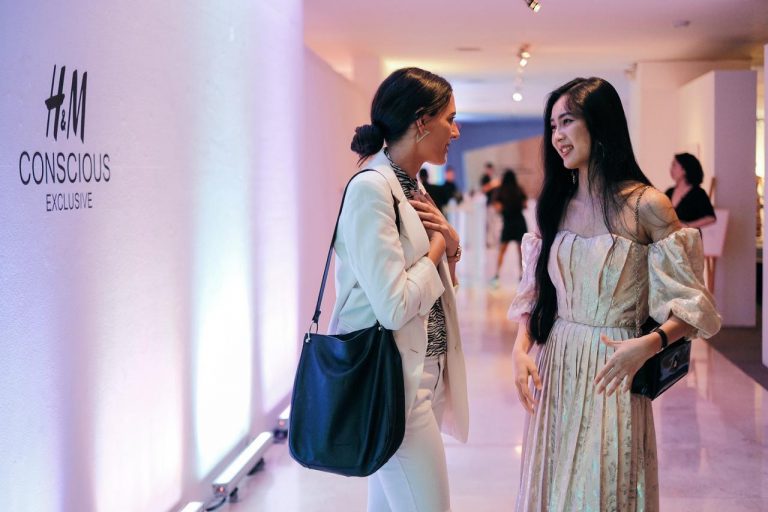Three things to keep in mind.
When H&M invited me to speak on their panel at the launch of their Spring Conscious Collection, I was momentarily conflicted.
For years I’ve been charging my way through what has felt like an upstream battle with the garment industry, sparking conversation around how our clothes are made. There have been countless moments of feeling like a broken record, with words like ‘transparency’, ‘ethics’ and the all time favourite ‘sustainability’ being thrown like darts to a board just trying to see what sticks.
Let’s be honest here.
Those words mean very little. They are as empty as a post-Marie Kondo closet. There is no instruction manual that comes with the goal of becoming a ‘better’ company (call it mindful, green, sustainable… whatever buzz word tickles your fancy).
So I was obviously conflicted in joining the launch of one of fast-fashion’s star players, especially as I was asked to speak about the social and environmental impact of the industry. Should we rejoice or feel skeptical?
For all those who might be as jaded about sustainability in fashion as I am, or are simply wondering if the launch of their new collection is essentially a new coat of greenwashing, here are three things to keep in mind.
- H&M’s collection is ACTUALLY made from sustainable materials.
Yes. It’s true. The fabrics that make up the garments in their new collection are made from insanely cool innovations in the textile industry. A whopping 57% of the material used in all H&M garments are recycled or come from other sustainable sources. Piñatex is a heavenly fabric made from pineapple husks sourced in the Philippines. I had the opportunity to chat with founder, Dr.Carmen Hijosa who will forever change the way I see the fruit. The company provides an alternative revenue stream for pineapple farmers in the Philippines, taking the leaves which are otherwise useless and re-enter them into the value chain, becoming an incredible leather-like fabric. H&M has also collaborated with other innovative companies like Orange Fiber and Bloom Foam. The company is using its size and scale to lead by example.

In just one year, H&M has almost doubled the amount of sustainably sourced products in their entire collection and aim to reach 100% recycled or other sustainably-sourced materials by 2030. Speaking of recycling…
MYTH BUSTER MOMENT #1 : It’s not easy to recycle most textiles. Just like any product on the planet, when you have a mix of materials in one product (ex. cotton with a little bit of polyester and rayon), it complicates the entire process of recycling. H&M Foundation is leading the way with the Hong Kong Textile Institute to spearhead new technologies that CAN do this. Finally. It’s the breakthrough the industry has been waiting for.
MYTH BUSTER MOMENT #2: Recycling isn’t the best case scenario. A world reliant on recycling is not the paradise we’re striving for. It takes resources and energy to transform an unwanted garment into something new, but buying something that is made from recycled materials can truly mess with our brains and trick us in thinking we can consume more ‘guilt free’. The feeling of ‘Why not! It’s sustainable!’ tends to increase consumption. Just because H&M has a take-back recycling program isn’t a reason to cycle through your wardrobe at a faster pace.
The big issue with the up trend to ‘make it recyclable’ as a solution to disposability has validated the production of single-use product streams. In many advanced recycling markets, we see an increase in the net use of disposable products, which has a collective loss of value of raw materials and ultimately produces bigger ecological issues.
– Leyla Acaroglu
2. Buying from a conscious collection doesn’t make you a conscious consumer.
I’ll be the first one to say that the pieces in their new conscious collection are tempting. Did I ogle at the pineapple leather rocker-chick vest? Yes. Picture myself wearing the Orange Fiber floral dress frolicking through a field of grass like a bohemian princess? Yes.

Will I buy either? No. Because buying only what you need is still the most sustainable thing you can do as a consumer. Outfitting yourself head to toe in sustainable fabrics does not qualify you as a conscious consumer. Quite the opposite. Wearing what you already own and love, or wearing what you’ve just swapped with a friend is still number one.
As Dr.Hijosa explained to me the multi-step process to make pineapple leather, I was amazed by just how much intricate work goes into producing just one square meter of fabric. The same thing can be said for most products on the market today. We overlook and underestimate how resource intensive it can be to produce our clothing. Buying more than what we need and recycling what we’re suddenly no longer interested in wearing means taking this for granted.
H&M’s Sustainability Manager at H&M Southeast Asia, Xin Yi Wong reinforced the importance of caring for the product itself to extend the life of garment. With the introduction of new textiles, the company is also taking the time to educate consumers on proper care methods.
3. Sustainable sourcing is just a piece of a bigger puzzle.
For anyone who hasn’t jumped on the sustainable fashion bandwagon yet, H&M’s launch is a big win. It targets the everyday shopper, the busy person without brain space to ponder the provenance of their t-shirt. Making sustainable fabrics accessible to the general public is a giant step in the right direction.
Their 2020 goal is a worthy one, but is just a portion of the bigger picture. Last year, the company wound up with $4.3 billion worth of unsold stock. Even if 57% of that stock was made from sustainably sourced materials, nobody can deny that bigger things needs to change.
Will H&M be the first to publicly declare a slowing down of production? A shift in their business model? No amount of recycling or sustainable sourcing can offset the innate sustainability issues that comes with the fast fashion model.
H&M is not greenwashing. They have worked hard at making changes (ones that are not quick or easy for such large organizations). It’s up to you not to fall into the trap of buying unnecessarily to support this transition. If you’re going to buy, buy from their conscious collection — but in the meantime, you can frolic in that lovely outfit you already own.
*This post was not sponsored by H&M.

About the Author
Laura A. François
Social Impact Creative and Founder
@anewkind.studio, Country Coordinator Fashion Revolution Day Singapore
www.laurafrancois.com
Some of Our Courses to Check Out
-
Advanced Certification in Apparel Merchandising
$1,500.00Original price was: $1,500.00.$750.00Current price is: $750.00.

